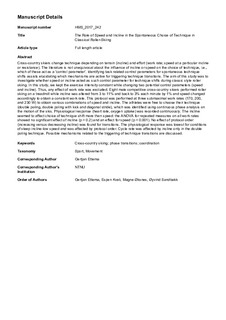| dc.contributor.author | Ettema, Gertjan | |
| dc.contributor.author | Kveli, Espen | |
| dc.contributor.author | Øksnes, Magne | |
| dc.contributor.author | Sandbakk, Øyvind | |
| dc.date.accessioned | 2017-10-30T15:05:03Z | |
| dc.date.available | 2017-10-30T15:05:03Z | |
| dc.date.created | 2017-08-24T13:33:52Z | |
| dc.date.issued | 2017 | |
| dc.identifier.citation | Human Movement Science. 2017, 55 100-107. | nb_NO |
| dc.identifier.issn | 0167-9457 | |
| dc.identifier.uri | http://hdl.handle.net/11250/2462969 | |
| dc.description.abstract | Cross-country skiers change technique depending on terrain (incline) and effort (work rate; speed at a particular incline or resistance). The literature is not unequivocal about the influence of incline or speed on the choice of technique, i.e., which of these act as a ‘control parameter’. Identifying task related control parameters for spontaneous technique shifts assists elucidating which mechanisms are active for triggering technique transitions. The aim of this study was to investigate whether speed or incline acted as such control parameter for technique shifts during classic style roller skiing. In this study, we kept the exercise intensity constant while changing two potential control parameters (speed and incline). Thus, any effect of work rate was excluded.
Eight male competitive cross-country skiers performed roller skiing on a treadmill while incline was altered from 3 to 11% and back to 3% each minute by 1% and speed changed accordingly to obtain a constant work rate. This protocol was performed at three submaximal work rates (170, 200, and 230 W) to obtain various combinations of speed and incline.
The athletes were free to choose their technique (double poling, double poling with kick and diagonal stride), which was identified using continuous phase analysis on the motion of the skis. Physiological response (heart rate, oxygen uptake) was recorded continuously.
The incline seemed to affect choice of technique shift more than speed: the ANOVA for repeated measures on all work rates showed no significant effect of incline (p > 0.2) and an effect for speed (p < 0.001). No effect of protocol order (increasing versus decreasing incline) was found for transitions. The physiological response was lowest for conditions of steep incline-low speed and was affected by protocol order. Cycle rate was affected by incline only in the double poling technique.
Possible mechanisms related to the triggering of technique transitions are discussed. | nb_NO |
| dc.language.iso | eng | nb_NO |
| dc.publisher | Elsevier | nb_NO |
| dc.title | The role of speed and incline in the spontaneous choice of technique in classical roller-skiing | nb_NO |
| dc.type | Journal article | nb_NO |
| dc.description.version | submittedVersion | nb_NO |
| dc.source.pagenumber | 100-107 | nb_NO |
| dc.source.volume | 55 | nb_NO |
| dc.source.journal | Human Movement Science | nb_NO |
| dc.identifier.doi | 10.1016/j.humov.2017.08.004 | |
| dc.identifier.cristin | 1488374 | |
| dc.description.localcode | This is a submitted manuscript of an article published by Elsevier Ltd in Human Movement Science, 12 August 2017 | nb_NO |
| cristin.unitcode | 194,65,30,0 | |
| cristin.unitname | Institutt for nevromedisin | |
| cristin.ispublished | true | |
| cristin.fulltext | postprint | |
| cristin.qualitycode | 1 | |
